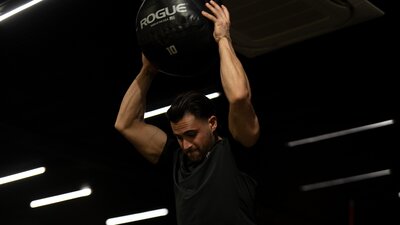Know Your Lifts
Lifting is a numbers game. Different levels of weight, or any resistance, can result in a different hypertrophic effect on the body. A lifter can work on their skills for strength, hypertrophy, or endurance to become a better athlete. Each category of lifting yields different results based on the volume and the effort.
Strength
Strength training is done by lifting close to one’s one-rep max (1RM). This style of lifting evaluates the body’s foundation by measuring its overall strength. They can be the most taxing because they involve the most recruitment in multiple muscle groups. Strength training is exercised through bilateral versions of the overhead press, bench press, squat, and deadlift. In most cases, they are the first exercise in a lifting session.
The volume calls for less reps with more sets, typically looking at the 3-6 rep range for 4-6 sets. For average weightlifters, training in higher loads of weight will increase their 1RM. It does not matter if sets are working to failure or not (1).
Lifters looking to pursue powerlifting or Olympic lifts should practice strength training. It is also good for people who want a simple workout since it allows them to hit all of the major muscle groups. Lastly, anyone short on time can rely on strength training for a good quality lift session.
Hypertrophy
Hypertrophy is a general term in athletics, meaning the enlargement of muscle tissue on a cellular level. In essence, any type of lifting can create hypertrophy. When it comes to lifting, it is known as the 8-15 rep range of an exercise for 2-4 sets.
Hypertrophy training compliments strength training, practicing muscle recruitment without as much strain. Compound exercises can also be practiced for hypertrophy by changing it into a unilateral movement or lowering the load. For example, a single-arm dumbbell bench press can support the strength for a barbell bench press. It’s a good way to improve strength through dynamic movements.
When it comes to volume, hypertrophy is seen as a baseline. It’s not as heavy as strength training and not as explosive as endurance training. Lifting for hypertrophy usually lies in the middle of a lifting session. Depending on the person’s style of lifting, it could even take up the majority of their session.
Hypertrophy is essential in the bodybuilding realm, sculpting out muscles by the fiber. It is also good for anyone who wants to isolate specific muscles in order to become better at another movement.
Endurance
Endurance training is the cherry on top of a lifting session. It improves the cardiovascular and musculoskeletal systems (2). The weight is relatively low, but that does not mean it’s supposed to be easy. Endurance increases exercise capacity and performance. Instead of being volume-centric, it is time and effort-based (2). When working with low weight, effort is more important than volume (3). This increases the heart rate in a similar manner to cardio while still conditioning the body. This can help athletes looking to shed excess body fat, especially if being lean is a goal.
When it comes to endurance, intensity matters more than volume. Most endurance training only involves the bodyweight. Between long slow-distance, sprint interval training, and high-intensity interval training, the latter two proved to be more effective in enhancing aerobic adaptations. Conversely, slow long-distance training improved respiration by 25% in a separate study (3). For lifters, it is possible to achieve endurance with weights, such as kettlebell training.
Endurance training is good for anyone who wants high-intensity. It can also help endurance athletes looking for a workout related to their respective training. Muscle mass can increase through endurance training, but only by about 7-11% (3).
How Will You Train?
The three categories of lifting can each achieve different results. Depending on an individual’s goal of mass, aesthetic, or stamina, they can focus the majority of their exercises on one of these styles. While strength training makes heavy weights look light, hypertrophy and endurance makes light weights look heavy. When practiced together, they can create a well-conditioned, healthy body.
Works Cited

